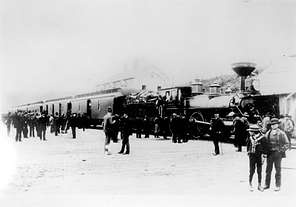Port Moody’s History
Port Moody has a rich history which we believe is important to share. Visit the POMO Museum or take a step into the past as you read about the events, people, and places that shaped Port Moody over the years.
Early First Nations history
Long before European explorers and settlers arrived, the lands around what is now Port Moody were inhabited and stewarded by Coast Salish First Nations communities. This area provided an ideal environment for fishing, hunting, and gathering, supporting thriving communities for generations.
Several Coast Salish groups frequented the area, including the kʷikʷəƛ̓əm (Kwikwetlem), səlilwətaɬ (Tsleil-Waututh), xʷməθkʷəy̓əm (Musqueam), Sḵwx̱wú7mesh (Squamish), q̓ic̓əy̓ (Katzie), qʼʷa:n̓ƛʼən̓ (Kwantlen), qiqéyt (Qayqayt), and Stó:lō (Sto:lo) Peoples, who are now formally recognized as having traditional, ancestral, and ongoing ties to Port Moody. Precontact villages and seasonal procurement camps were situated around the inlet to harvest a wide range of marine and terrestrial resources. This seasonal movement underscores Indigenous knowledge of local ecological cycles and resource management practices, reflecting a way of life that sustained communities for thousands of years.
Through place names, traditional narratives, and dialogue with current leaders and elders, we are learning about the history and cultural importance of this waterway. Strong connections to these lands remains today. Visitors and residents alike are encouraged to honor and learn about the rich cultural history of the Coast Salish peoples who have shaped and continue to enrich the community of Port Moody.
Early settler history
Early settler history in Port Moody was dominated by two events: the 1858 gold rush in the Fraser Valley and the 1886 arrival of the first transcontinental train. With the sudden appearance of thousands of gold prospectors in the Fraser Valley, and the need to develop a back-door defence for the burgeoning town of New Westminster, the Royal Engineers (commanded by Col. Richard Moody, after whom Port Moody was named in 1859) were directed to clear a trail from the new capital of British Columbia to the Burrard Inlet.

The trail, later known as North Road, would allow ships anchored in the Burrard Inlet to unload military supplies and personnel if New Westminster was attacked from the south. No attack occurred. But a town, at first no more than a cluster of tents and shacks, began to grow, spurred on by several land grants to some of the Royal Engineers. One of them was John Murray, who eventually owned about half of the town. His son, also named John, later was responsible for many street names – Murray, John, George, William, Henry, Jane, Mary, etc. The main thoroughfare, St. John Street, is a misnomer: John Jr. – police officer, alderman and general mover and shaker – in error put “St.” in front of, instead of behind, “John”. So the official survey gave the street the name it has today. The late Major J.S. Matthews, the Vancouver archivist, supposedly said, when he heard of the street name: “Johnny Murray was no saint.”
The western terminus
Port Moody had an “early moment of fame” in the newly formed nation of Canada. In 1879, the town was officially named western terminus for the Canadian Pacific Railway, the transcontinental line promised in 1871 by Prime Minister, Sir John A. Macdonald, to entice British Columbia into Confederation. The first passenger train from Montreal arrived in Port Moody at noon on July 4, 1886, with about 150 passengers after a 139-hour, (4,655 km) trip.
Speculation caused by the imminent arrival of the railway had been rampant; in 1885 a man bought most of the land along Clarke and Queens streets for $15 and sold it later the same year for $1,000. Port Moody was expected to become the biggest town in the west, but William Van Horne decided the company would extend its rail line from Port Moody to a new terminus several kilometres farther west, newly named Vancouver – the railway's executives had determined Port Moody's narrow shelf of land between water and hillside to be insufficient for expansion. There was amazement and anger when the decision became known, and unsuccessful lawsuits were launched. The near-ecstasy of the first train's arrival in Port Moody soon faded. A cairn in Port Moody commemorates the “completion of the Canadian Pacific Railway”. There is no cairn for William Van Horne. Port Moody's population was static at 250 for nearly twenty years.
Industry in the early 1900s
J.S. Emerson built a sawmill for cutting cedar in 1905. Records show 125 men were employed there: 34 white men, 80 Chinese, 5 Japanese and 6 Hindustani. At about the same time, several oil refineries opened, followed in 1915 by the large Imperial Oil Company development just outside the Port Moody boundary. In 1913, Port Moody was incorporated as a city. The first city hall was built and Perry A. Roe, the owner of a local sawmill, became the first mayor.
Port Moody was primarily a mill town, full of smoke and the whine of lumber being cut into boards and shingles. If you walked down a street in the early 1920s, you would have seen mostly private homes with gardens in the back and laundry on the lines. There were five or six general stores selling everything from shoes to steak, three hotels, two gas stations, an elementary school and one police officer. There were no fire fighters. When one of the sawmills caught fire, a series of shore whistles were blown and everyone pitched in to help fight the fire.
Post-war Port Moody
With the outbreak of the Second World War, people were able to find steady employment. After the war the town began to expand geographically, and like many towns in North America, became increasingly suburban. In the following decades the process continued as large companies like Andres Wines, Gulf Oil, Weldwood, Interprovincial Steel, Reichold Chemicals and Pacific Coast Terminals opened up plants in the Port Moody area.
Contact Us
City Hall
100 Newport Drive
Port Moody, B.C.
V3H 5C3
604.469.4500
Email
